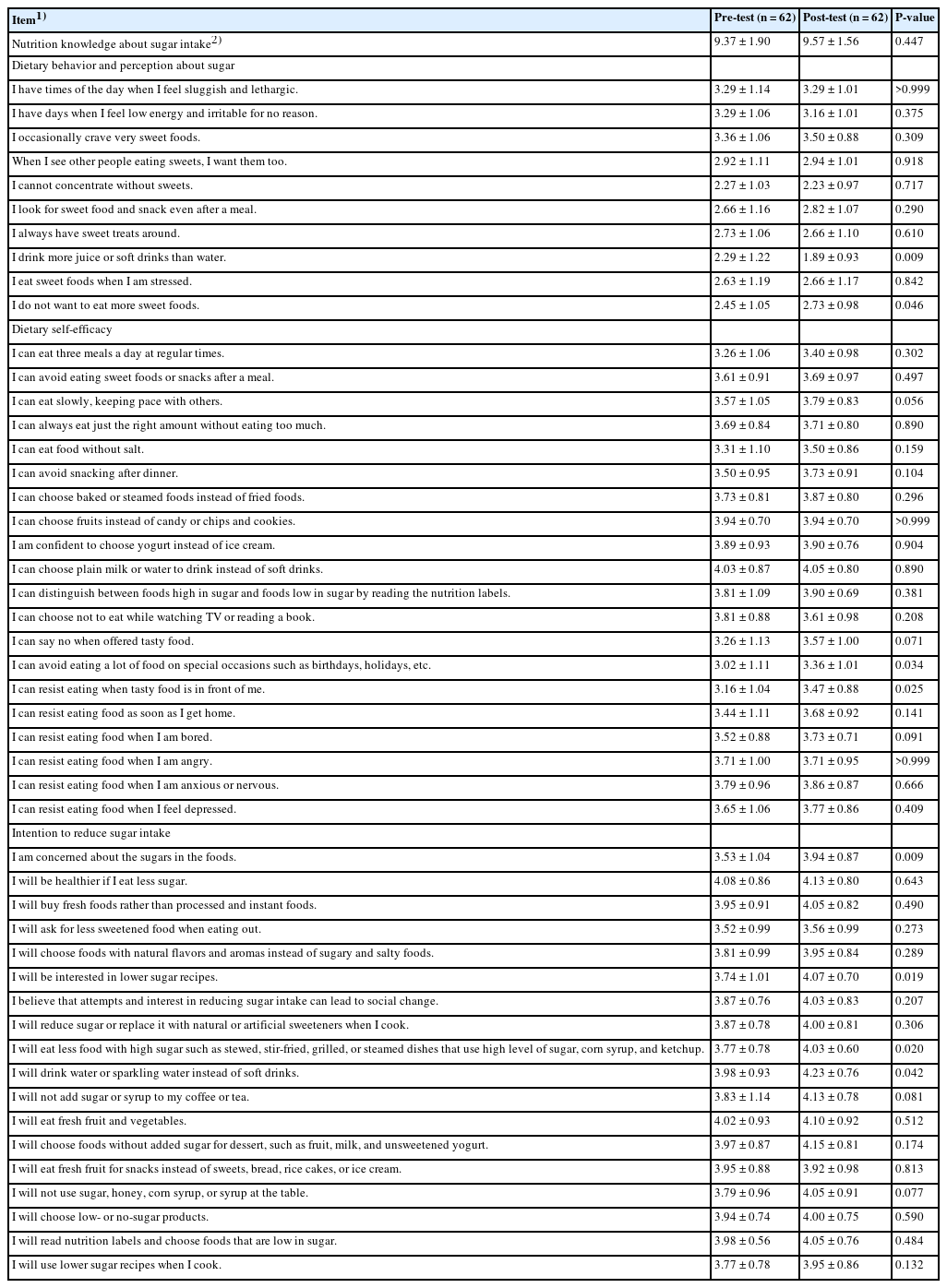Search
- Page Path
- HOME > Search
Research Articles
- [Korean]
- Development and application of a dietary program to reduce sugar intake using a living lab approach in Korea: an intervention study
- Jung-Hyun Kim, Min Sook Kyung, Seul Ki Choi
- Korean J Community Nutr 2024;29(6):504-513. Published online December 31, 2024
- DOI: https://doi.org/10.5720/kjcn.2024.00318

-
 Abstract
Abstract
 PDF
PDF PubReader
PubReader ePub
ePub - Objectives
This study aimed to develop and apply a dietary program to reduce sugar intake among community residents using a Living Lab approach.
Methods
We developed and applied a community-based dietary program to reduce sugar intake. Participants were recruited from community organizations, including a children’s food service management center, elementary to high schools, a university, a family center, a community health center, and an elderly welfare center. The dietary program was conducted in two phases; start and next levels. The start level included a pre-assessment of dietary behaviors and participation in educational platforms, whereas the next level included activities using educational platforms, tailored mission and feedback, and pre- and post-surveys. Extension educators at each community organization implemented the dietary program following organization-specific guidelines. Changes in participants’ nutrition knowledge, dietary behaviors and perceptions, self-efficacy, intention to reduce sugar intake, and participants’ program satisfaction were analyzed using paired t-tests.
Results
In total, 1,238 and 339 individuals participated in the start and next level, respectively. Participants reported significantly lower scores on dietary behavior items regarding drinking more juice or soft drinks after program participation (P = 0.009) and craving sweet foods (P = 0.046). They reported a higher intention to take interest in sugar content in food (P = 0.009) and lower-sugar recipes (P = 0.019), eat less food with high sugar content (P = 0.020), and drink water or sparkling water instead of soft drinks (P = 0.042). Nutrition knowledge did not significantly change after program participation. Program satisfaction significantly increased from the start level to the next level (P<0.050).
Conclusion
This study showed the potential of using a Living Lab approach to implement community-wide dietary interventions. Further research is required to evaluate the effectiveness of the Living Lab approach in various community settings.
- 114 View
- 11 Download

- [English]
- Total sugar intake and its contributed foods by age groups in Koreans using the 8th (2019–2021) Korea National Health and Nutrition Examination Survey: a cross-sectional study
- Hyejin Yu, Sang-Jin Chung
- Korean J Community Nutr 2024;29(3):222-233. Published online June 30, 2024
- DOI: https://doi.org/10.5720/kjcn.2024.29.3.222

-
 Abstract
Abstract
 PDF
PDF PubReader
PubReader ePub
ePub - Objectives
This study was conducted to investigate the status of total sugar intake and contributing foods in Korea according to age groups.
Methods
This study used 24-hour dietary recall data from the 8th Korea National Health and Nutrition Examination Survey (2019–2021) to investigate the nutritional and total sugar intake status among Koreans. A total of 18,338 research participants (≥3 years old) were included in this study. To analyze the types of foods contributing to total sugar intake, these foods were categorized into 15 types. Moreover, we examined the total sugar intake and ranked the most consumed foods by age groups (3–11 years, 12–18 years, 19–34 years, 35–49 years, 50–64 years, over 65 years). A survey procedure was employed for statistical analysis.
Results
The energy intake ratio from total sugars was approximately 12%–15%, which was within the recommended range. However, the proportion of individuals consuming total sugar exceeding 20% of their total caloric intake is nearly 20%, raising concerns about excessive sugar consumption. Furthermore, the percentage of participants whose intake of sugar from processed foods exceeded 10% of their total calories was highest in the 12–18 age group at 37.1%, followed by the 3–11 age group at 35.2%, and the 19–34 age group at 34.0%. Carbonated drinks, cola, and cider were the primary foods consumed by children and adolescents (3–18 years old) and young adults (19–34 years old). For middle-aged and older adults, mixed coffee with sugar and cream was a prominent contributor to sugar intake.
Conclusions
This study investigated sugar consumption patterns among Koreans, finding the principal foods contributing to this intake. Identifying these contributors is pivotal, given their potential impact on public health.
- 1,362 View
- 47 Download


 KSCN
KSCN
 First
First Prev
Prev



